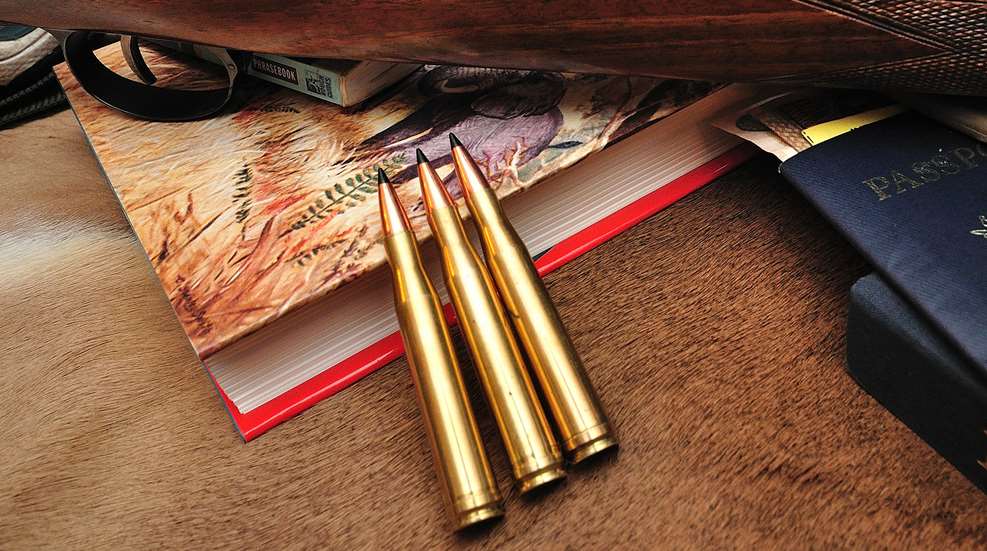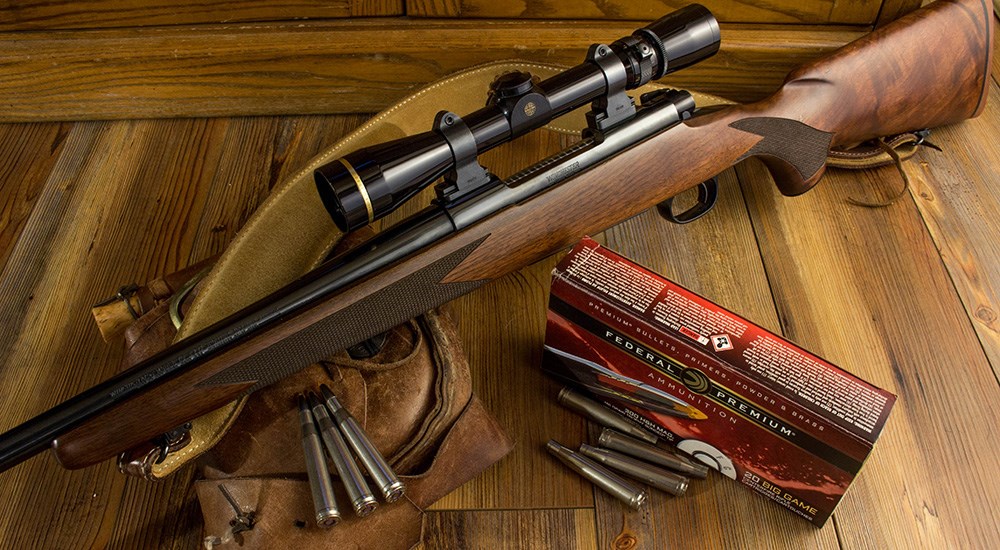
“May I see that rifle again?” Namibian Professional Hunter Jamy Traut and I had just taken a handsome Hartmann’s mountain zebra stallion on the rugged Namib Escarpment, at just under 300 yards, with a late 1950s-vintage Colt Coltsman rifle. Based on a FN-Mauser action, the classic rifle was simply marked “.300 Magnum” on the barrel. You see, this rifle was chambered in the .300 Holland & Holland Magnum; there was no other .300 magnum on the market (other than the proprietary .300 Weatherby Magnum, which was still an oddity), as the .308 Norma Magnum and .300 Winchester Magnum wouldn’t see the light of day until a few years later.

Released in 1925, the .300 H&H Magnum would garner a great reputation on both sides of the pond, and would have its fair share of fame; Jamy Traut and I share a love of classic cartridges, and this is why he looked longingly at that rifle all week long (for the record, I offered—on several occasions—to let Jamy take an animal with my rifle, but he never accepted). The .300 Holland & Holland Belted Magnum, or the .300 H&H, or the Super .30 (it is known by multiple names) was the fourth in the line of belted cartridges from the British firm of Holland & Holland. The first was the .400/.375 Belted Nitro Express, also known as the Velopex, which was released in 1905, followed by the famous .375 H&H Belted Magnum and its lesser-known sibling, the .275 H&H Magnum, both released in 1912.
What exactly is all this belted business about? I’m glad you asked. Where a rimmed cartridge offers very consistent headspacing, using the rim to stop any forward motion of the cartridge within the chamber, those rimmed cartridges don’t really feed well from a box magazine. The rimless designs rely on the shoulder of the case for headspacing, and variances in factory ammunition—specifically the location of the shoulder—could quickly lead to accuracy issues. Holland & Holland’s solution was to place a small belt of brass above the extraction groove, in order to best blend the benefits of the rimmed and rimless cartridges; it uses the belt for headspacing and can afford the slight shoulder associated with easy-to-feed cartridges.

1925 was the same year that the .270 Winchester was released in the Winchester Model 54 bolt-action rifle; the desire for speed was on, and it wasn’t long before America embraced the .300 H&H Magnum. The fact that Winchester and Western adopted the cartridge certainly didn’t hurt things either. It didn’t take off immediately, but a decade after its release Ben Comfort would use the .300 H&H in a Griffin & Howe rifle built on a Remington 30-2 action, to win the 1,000 yard Wimbledon Cup. The .300 Holland & Holland Magnum would also be in the hands of one John Amos Nosler, as he became increasingly frustrated over a bull moose that just wouldn’t die. Author Robert Ruark put the .300 H&H Magnum in the hands of fictional Professional Hunter Brian Dermott in his novel Uhuru.

What is it about the .300 H&H Magnum that generated all the nostalgia and romanticism? Well, it does offer a respectable velocity advantage over the benchmark .30-06 Springfield, though that comes at the price of needing a magnum-length receiver, and a large bolt face opening. The additional velocity will deliver a higher recoil level, yet I’ve never had a .300 Holland at the bench which I found intolerable. The slight, 8½-degree shoulder allows the cartridge to feed as if it were greased, and extraction is equally effortless. Having a case length of 2.85 inches, and an overall cartridge length of 3.60 inches, the .300 H&H will require a magnum-length action. Pushing a 180-grain bullet to right around 2875 fps, it’ll give a 150 to 175 fps over the Springfield, and will rival the .300 Winchester Magnum (modeled to mimic the performance of the Super .30); this is not a bad place to be at all. As Mr. Nosler proved, the power of the .300 Holland can certainly show the benefits of a premium bullet—and the Nosler Partition he designed as a result of his encounter with that bull moose remains a perfect choice—yet the velocity isn’t so high that a cup-and-core bullet is out of the question. In fact, I have found the .300 H&H Magnum to be a very well-balanced cartridge, and feel it has all the characteristics of an all-around hunting cartridge.

Unlike many of the later .300 magnum designs, the .300 Holland & Holland Magnum can use the full gamut of .30-caliber bullets very well; many of the larger and faster cases don’t like the lighter bullets at all. I’ve seen the .300 H&H drive 125-, 130-, 140- and 150-grain bullets into very respectable groups, yet at the same time, it’ll deliver the goods with the 180-, 200- and 220-grain slugs to cover the larger and heavier species. That Coltsman rifle absolutely loves the 180-grain spitzers like the Federal Trophy Bonded Tip, Swift Scirocco II and Federal Terminal Ascent, as well as the 150-grain Hornady InterLock, and the 220-grain Nosler Partition round nose. Now, a very dear friend has purchased that Colt rifle, and I've replaced it with a post-’64 Winchester Model 70, which came to me via another pal who just didn’t use the rifle. That Winchester has the prettiest piece of three-dimensional walnut I’ve ever seen on a production-grade Winchester. That Model 70 shows a definite propensity for bullets with a longer bearing surface; in fact, the load that shoots best from that rifle is Nosler’s 200-grain AccuBond load, driving that bullet to 2,750 fps for 3,350 ft-lbs of muzzle energy. I can’t really think of too many situations where I’d grab a .30-caliber rifle for a hunt and that combination wouldn’t suffice.

Sadly, in spite of the history and grandeur associated with the .300 H&H Magnum, it has all but faded into obscurity among the commercial manufacturers of ammunition, and has been left to left to the handloaders to keep the flame alive. As a devout handloader, I have spent a considerable amount of time creating viable .300 H&H Magnum loads. Were I pressed to choose one powder to fuel this cartridge, it would be Alliant’s Reloder 22, and I’d spark it with a Federal Gold Medal Match GM215M primer. Other viable choices are IMR 4350, H414, H48321SC, Reloder 19 and 25, IMR 7828 and AA4350. Pick a .30-caliber bullet which will fit the hunting scenario for which you’d take the .300 Holland, and I bet you’ll find a worthy handload for it without much trouble.
For the double rifles, there is a flanged (we say rimmed here in America) version, and it is the ballistic equivalent of the Belted Magnum; should you find rifle chambered for the flanged version, do not have an aversion to that variant. It will make a sound choice at any sane hunting range.

The .300 H&H has been my light rifle on more than one African safari, and with it I've taken eland, hartebeest, gemsbok and zebra. Here in the U.S., it has been a friend in the deer woods, and I look forward to taking my first black bear with the Super .30; I would also love the opportunity to sort out elk and moose—and just about any other North American species—with the classic design. Simply put, there are few times when a company gets a cartridge design right the first time around; Holland & Holland got it right in 1925 with the .300 H&H Magnum. I’m sure glad I jumped at the opportunity to spend time with this revered cartridge; it has certainly become a dear friend, and a welcome addition to my rifle lineup.



































